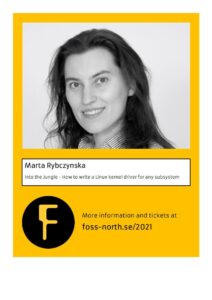Last updated: September 20, 2021
Do you know that more than one in ten kernel developers in the latest 5.14 Linux kernel is a new developer? It means that they have had their first (ever!) patch accepted into this version. In addition, this is not a single event. In fact, it is happening for every single version in the recent history.
This will be the beginning of one of the two talks from Marta Rybczynska, Syslinbit founder, at the Open Source Summit/Embedded Linux Conference 2021 (schedule available). The conference starts in a week. You can download slides from both talks in advance. Let us start from the first one – “From an Idea to a Patch in the Linux Mainline”. This is the third edition of the popular tutorial, updated with the recent content. If you are afraid of submitting your first Linux kernel patch, this is a session to follow. Marta takes a practical, step-by-step approach.
Set-up
The first step is to set up everything needed for the work. This starts from finding the right problem. Marta’s suggestion is to start with a bug fix or an improvement. If you are working on a new feature, it is likely you are going to fix bugs found during the development. Or adjust some internal kernel interface. Those also could be a good sources for a first patch. The tutorial suggests to avoid complex new features at the beginning. At least before you feel confident with the process…
When we do have the right problem, the next step will be setting up the development machine. This includes installing dependencies, downloading the kernel source tree (or more kernel source trees), getting familiar with the kernel source code indexing.
Then the tutorial moves on finding the bug source, illustrating it with an example of a real kernel bug. Marta shows how after the initial trace, we analyze the source. With the analysis come possible ideas of the bug source. The audience is then invited to repeat the procedure with a (fixed) bug of their choice.
Source analysis is not always enough. We might need kernel debugging tools. The tutorial covers the techniques for showing debug messages. It mentions printk() (currently rarely used directly), the general-purpose pr_* family with functions like pr_err(), and dev_* functions, like dev_err(), frequently seen in device drivers. Then it covers other techniques like tracing, performance monitoring, in-kernel debugging, and kernel testing framework.
Fix preparation
When the actual fix is done, the part many people fear is preparing and submitting the patch itself. The tutorial gives a gentle overview of the Linux Coding Style summary on one slide. Detailed instructions on checkpatch.pltake more than one, however. When the solution is ready, the time comes for the commit message with all important parts explained. This includes what Signed-off-by means and why it is important. At this point developers need a list of people to send the message to: maintainers and appropriate mailing list… Then the only thing is formatting the email, with the step-by-step commands for setting up git send-email. There are also some things to avoid when sending to the Linux Kernel Mailing List (abbreviated LKML), like sending attachments.
This is common to have a patch accepted in the 2nd (or later!) version. The talk concludes this part with tips on handling the review, like reposting after one week without a reply and checking if the distribution list is appropriate.
Some members of the audience might be working on something different than a bug. There is an additional section for them. This section includes working with low maturity patches called RFC (Request For Comments) and splitting a bigger change into a patch set.
With this set of tips and tools the audience will be equipped enough to send their first patch. The same procedure applies to many other Open Source projects, with slight modification to the tools and procedures to use.
Resources
The slides of the talk are waiting at the conference schedule page https://sched.co/lAS5 and everyone can review them before the event.
If you are interested this talk, you might also have a look at the one about working with unfamiliar code from foss-north.
